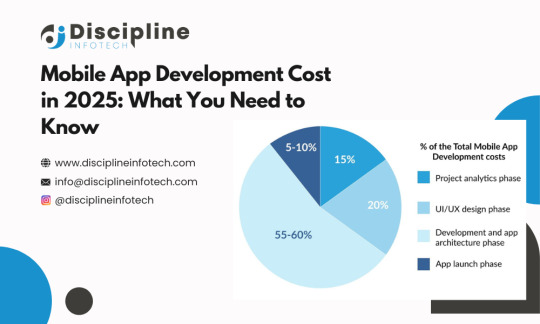#app development cost breakdown
Explore tagged Tumblr posts
Text
What Can We Expect to Pay for Mobile App Development in 2025?

As businesses increasingly invest in digital solutions, understanding mobile app development cost is crucial for planning and budgeting. In 2025, several factors will influence mobile app development costs, including complexity, features, and the latest mobile app UI UX design trends.
Key Factors Affecting Mobile App Development Costs
App Complexity
Simple apps: Basic features, minimal UI, lower mobile app making cost.
Medium complexity: Advanced features like payment gateways, real-time chat.
High-end apps: AI integration, IoT connectivity, and custom animations.
Platform Choice
Native (iOS/Android): Higher cost to develop an app due to separate coding.
Cross-Platform: More budget-friendly, faster development.
Latest App Design Trends
Adopting mobile app design trends like dark mode, 3D elements, and gesture-based navigation enhances user engagement.
Staying ahead with app design trends 2024 ensures a modern, competitive look.
Development Team
Hiring an experienced team like Discipline Infotech impacts mobile app development costs, but ensures quality and efficiency.
Ongoing Maintenance
Post-launch updates and security patches contribute to how much does it cost to develop an app in the long run.
Obtain the Finest Services for Developing Mobile Apps
Discipline Infotech provides premium mobile app development services that are customized to meet your requirements. Whether you're looking for a cost-effective solution or a feature-packed application, we ensure your app is built using the latest app design trends while keeping costs optimized.
Looking for clarity on how much for app development in 2025? Get in touch with us today!
#mobile app development cost#Cost to Develop an App#mobile app development costs#How Much Does It Cost to Develop an App#how much for app development#mobile app making cost#Mobile App Development Services#App Development Cost Breakdown
1 note
·
View note
Text
#app development cost#app development#mobile app development cost#mobile app development#app development outsourcing cost#cost of app development#software development#app development company#app development costs#future of ai app development#mobile app development cost estimate#app development cost breakdown#ai app development company#ai development company#app development estimate cost#how much app development cost#app development for startups
1 note
·
View note
Text
#cost to build an app in USA#app development cost USA#iOS app development cost#Android app development pricing#mobile app development USA#app development budget#app development pricing guide#app cost estimation#USA app development services#app development cost breakdown#app development trends USA
0 notes
Text
Estimating Rummy Game Development Costs in 2024
Rummy games have surged in popularity within India's gaming landscape, with the online real rummy market projected to hit an impressive ₹1.4 billion by 2024, according to Statistica. This exponential growth signifies a burgeoning market ripe for exploration, making Rummy game development an enticing prospect for businesses aiming to capitalize on this trend.
Market Expansion and Preference: The appeal of Rummy extends beyond Indian borders, cementing its status as one of the top 5 most favored card games globally. This widespread popularity, particularly in India, is further fueled by the increasing penetration of mobile devices, which provides accessibility to a larger audience.
Preference between Standalone Apps and Multigaming Integration: Both standalone Rummy applications and integration into multigaming platforms garner significant traction among players. However, overlooking Rummy's integration into multi-gaming platforms could be a strategic misstep. Integrating Rummy into a multi-gaming platform not only enhances user engagement but also broadens the platform's appeal, potentially attracting a diverse user base.
Why Real-Money Platforms Favor Rummy: Despite its distinction from traditional casino games, Rummy offers players a compelling gaming experience with minimal house advantage. This unique characteristic, coupled with its enduring popularity, makes Rummy an attractive proposition for real-money gaming platforms. The inclusion of Rummy often translates into higher player engagement and revenue generation for these platforms.
Game Development Considerations: Various factors influence the cost and scope of Rummy game development. Critical decisions include choosing between standalone and multigaming platforms, as well as selecting Rummy modes. Each mode, whether it be Points, Pool, Deals, or Raise, comes with its own set of complexities and development requirements. Additionally, integrating features such as tournaments and events can significantly enhance user engagement but may also impact development timelines and costs.
Mobile Platform and Additional Features: When developing a Rummy game for mobile platforms, businesses must weigh the pros and cons of native versus cross-platform applications. Cross-platform solutions offer versatility by catering to multiple mobile operating systems, thereby maximizing reach and minimizing development efforts. Furthermore, the inclusion of additional features beyond the basic gameplay, such as social features, in-app purchases, and player customization options, can elevate the gaming experience and drive user retention.
Cost Estimation: The cost of Rummy game development can vary significantly depending on project requirements and complexity. Basic Rummy games may start at around ₹5 lakh, catering to simpler features and platforms, while more advanced projects with extensive features and multi-platform support can cost upwards of ₹1 crore. It's essential for businesses to collaborate with experienced development partners like Enixo Studio to accurately assess project scope and obtain customized cost estimates.
Conclusion: As the Rummy gaming market continues to flourish, businesses must carefully evaluate their development strategies to capitalize on this lucrative opportunity effectively. By considering factors such as platform integration, feature set, and development costs, businesses can navigate the dynamic landscape of Rummy game development and position themselves for success in India's gaming industry. For reliable and efficient development services, companies can leverage the expertise of Enixo Studio to achieve their Rummy game development goals.
#Rummy game development cost#Rummy app development cost#Rummy game cost estimation#Rummy game budgeting#Rummy software development pricing#Rummy game development expenses#Rummy game development pricing#Rummy game cost breakdown#Rummy game development investment#Rummy game development quote
1 note
·
View note
Text
#Affordable mobile app development services USA#Award-winning mobile app developers USA 2024#Benefits of hiring app developers for healthcare solutions#Cost-effective medical billing software development#Custom healthcare app development company expenses#Custom mobile app solutions by USA-based developers#Expert mobile app developers for hire in the USA#mobile app development company in the USA#Secure medical billing system development cost breakdown#Tailor-made medical billing app development insights#Top-rated mobile app development company in USA 2024
1 note
·
View note
Link
#understanding the costs of developing a react native app#how much does it cost to develop a react native app?#factors affecting the cost of react native app development#react native app development cost breakdown#react native vs native app development: which is more cost-effective?#tips to minimize react native app development costs#how to estimate react native app development costs#react native app maintenance costs: what to expect?#real-life examples of react native app development costs#hiring a react native app development team: how much should you budget?
0 notes
Text
Development Update - May 2023

Hello hello folks, Miyazaki here! We've got a big update for this month--we've rolled out Mythaura's battle demo and are so excited for you to give it a try!
Topics covered include:
Battle Demo & Guide
Quarter 4 (2023) Rewards Reveal
Beast Creator Contest
New Homepage Splash Screen
More info available under the cut!

Battle Demo Guide
Welcome to Mythaura's battle demo! Here's a concise guide to help you navigate the 3v3 battles and make strategic decisions:
1. Battle Setup
The battle takes place between your beasts (on the left) and the enemy beasts (on the right) and ends when one side is defeated. For this demo, all beasts in this demo are level 1 and have average size for their species.

2. Beast Details
Click on the info icon in the corner of your beast's avatar to view its details. From here, you can read their abilities and see a breakdown of their stats.

3. Elements
Each beast has 2 elements, including a species element that is always shown. You won't know your opponent's secondary element.
For this demo, a beast's secondary element is currently randomized.
Check the elements page for more information on elements and for a breakdown of type effectiveness.
4. Turn Actions
Each turn, your beasts can perform one of the following actions:
Use an ability or surge ability.
Defend themselves or an ally.
Rest to regain stamina.
Once all players have submitted their actions, the round is resolved with the following priority:
Resting beasts rest first.
Defending beasts defend next.
Abilities are resolved.
Within each action type, the order is determined by ability priority, beast speed, weight (with lightest going first), and then randomly if all those values are the same.
5. Abilities
Beasts start with 4 abilities: one surge ability (species-based), one neutral ability, and one ability for each element. If a beast's species and individual element match, they will have 3 abilities.
Abilities with elements can be super effective or resisted, affecting the damage dealt. Pay attention to moves' effectiveness and your foes' abilities for better results.
Abilities incur fatigue and the fatigue cost is shown on the ability button.
Abilities will generally have a small chance to miss or be a critical hit. The chances of these can vary per ability.
Abilities have 3 types: Combat, Projection, and Support.
Combat: Attack vs Defense
Projection: Focus vs Barrier
Support: Non-damage dealing abilities

6. Surge Abilities
When a beast's surge meter is full, they can use their surge ability for a powerful effect. Surge abilities don't incur fatigue and never miss. After using a surge ability, the surge meter goes back to 0%. Please note that the surge abilities in this demo may be changed before the game’s official launch.
7. Defending
Beasts can defend themselves or allies, reducing incoming damage by 75% for that turn. This effect does not stack. Defending slightly charges the defender's surge meter and recovers a small amount of stamina.
8. Resting
Resting recovers a substantial amount of stamina and a small amount of health.
Remember, understanding abilities, elements, defending, and resting will help you make the best decisions during battles. We have provided an in-app form you can use to report bugs and provide feedback. Good luck and enjoy the demo!

Planned battle demo updates for the future:
A "quick queue" button that queues with the first available other quick-queue person and does not require a PIN
PvE Mode versus an ai battler
Timeout for move submission
Controller support
Weather effects
Ailments
Ability to set desired element from the queue screen
Better reporting and improvements to history, such as remembering when you discover a super effective element on a specific opponent

Quarter 4 (2023) Rewards Reveal
Our Quarter 4 rewards have been completed and are ready for their public debut! Thank you to the Ko-fi Sponsors who voted on the different Glamour and Companion concepts, we appreciate your support and feedback.
Q4 (2023) Glamour: Koi Pond


Q4 (2023) Companion: Blooming Jackalope


Q4 (2023) Solid Gold Glamour: Adult Basilisk


Special One-Time Companion: Radiant Golden Ossiflage
1x copy will be awarded to all previous and/or current Bronze, Silver, and Gold Sponsors

Sponsors of all levels may purchase one (1) additional copy of the Radiant Golden Ossiflage in our Ko-fi Shop.

Beast Creator Contest
We're back with another Beast Design Contest! We're looking forward to all the fantastic creations that this community comes up with.
Here are the parameters:
Each individual can submit one (1) Beast option for consideration
Any species fine (babies included)
Fill out Google form; provide both a picture and the preview code
We’ll pick three winners to have their Beasts featured on the front page for Quarter 1 (July 1 - September 30). Winners will also receive:
1x Beta Key
1x Quarter 4 (2023) Skin: Koi Pond
1x Quarter 4 (2023) Companion: Blooming Jackalope
These rewards will be applied directly to your account.
Submissions for the Beast Design Contest are due by June 15, 2023. The form will close at 11:59pm PST. Winners will be announced in the July 1, 2023 Development Update.

Homepage Splash Screen

Our wonderfully talented senior artist, Luci, created a scene detailing an early stage in a group of adventurers' journey in Mythaura. This perfectly captures the vibe of the opening series of introductory quests that players will undertake at the start of the game. We hope you enjoy the art, and hope that you look forward to playing through Mythaura's single-player story when we launch!

Mythaura v0.17
Updated homepage layout
Merged and finalized battle demo, fixing several bugs found along the way

Thank You!
Thanks for sticking through to the end of the post! We hope you love the battle demo and are looking forward to your feedback, which will help shape the nature of the game while still in its early development--leading to a lasting impact when Mythaura launches. Your help here is invaluable!
See you around the Discord!
#mythaura#petsite#virtual pet site#pet site#development update#griffin#dragon#unicorn#peryton#ryu#quetzal#basilisk#kirin#indie game dev#indie games#rpg#rpgs#roleplay games#browser rpg#browser game#game dev#game development#hippogriff#dev update
203 notes
·
View notes
Text

How much microplastic are you drinking? New tool can tell you in minutes
Micro- and nanoplastics are in our food, water and the air we breathe. They are showing up in our bodies, from testicles to brain matter. Now, University of British Columbia researchers have developed a low-cost, portable tool to accurately measure plastic released from everyday sources like disposable cups and water bottles. The device, paired with an app, uses fluorescent labeling to detect plastic particles ranging from 50 nanometers to 10 microns in size—too small to be detected by the naked eye—and delivers results in minutes. The method and findings are detailed in ACS Sensors. "The breakdown of larger plastic pieces into microplastics and nanoplastics presents significant threats to food systems, ecosystems, and human health," said Dr. Tianxi Yang, an assistant professor in the faculty of land and food systems, who developed the tool. "This new technique allows quick, cheap detection of these plastics, which could help protect our health and ecosystems."
Read more.
#Materials Science#Science#Plastics#Polymers#Environment#Fluorescence#Sensors#University of British Columbia
16 notes
·
View notes
Note
hey sorry if this isn't something you normally do but do you or any of your followers have any resources on how to start playing Mutants and Masterminds? I started a superhero game in an indie system that the developers dropped and my group has been trying to move it over to M&M but the system is confusing us (probably because we're trying to port things over, but still).
I’m definitely going to need some help from my followers here, so I’m pushing this forward in the queue. For now, let’s talk about what I found that might be helpful.
Weeknight Hero’s Video Tutorials Weeknight Hero has a series of video tutorials teaching various aspects of M&M, including a playlist for Character Creation and Campaign Creation. They also have examples of creating specific well-known characters, as well as some reviews of combat. There’s just a lot of content here, but none of the videos look terribly long, so if you’re able to sit down and watch a few videos, this might be helpful for you.
Free Ronin Green Ronin appears to have a database of all of their free Mutants & Masterminds content for 3rd edition, including character sheets, example characters, and free adventures. There’s a lot of example characters here, which might be helpful in playing a simple one shot to get used to the system.
Hero Lab Character Creation Looking through the M&M Reddit forums, it looks like the online community swears by the Hero Labs app for help in character creation. It looks like you have to pay for the online M&M data needed to make characters, so this is probably only helpful if your play group is willing to put a little bit of money towards the software. Then again, if character creation is what’s really making things difficult, it might be worth the cost.
The Mutants & Masterminds Reddit Wiki. There’s a whole list of resources for new players and GMs on the M&M reddit community, including character creation examples, different character sheets, sample characters, and tips for new GMs.
D20HeroSRD Wiki This is an open-access wiki that has a lot of breakdowns for various elements of Mutants & Masterminds. There’s pre-made archetypes here to take a look at, a glossary of terms for folks who are having a hard time parsing things in the book, and breakdowns of gadgets, gear, vehicles, and other things that your characters might want to have (and use) in your game.
I hope you found this helpful!
36 notes
·
View notes
Text
How Much Does React Native App Development Cost in California?

With the growing demand for mobile applications, businesses are increasingly opting for cross-platform solutions like React Native to reduce development time and costs. California, being a tech hub, has a vibrant ecosystem of app development companies, but the cost of development can vary significantly based on several factors. In this blog, we’ll explore the cost of React Native app development in California and what influences the pricing.
Factors Influencing React Native App Development Cost
1. Complexity of the App
The complexity of your app plays a crucial role in determining the cost. Apps can be categorized into three levels of complexity:
Simple Apps – Basic apps with minimal features, such as a calculator or to-do list. ($10,000 - $30,000)
Medium Complexity Apps – Apps with additional functionalities like user authentication, API integration, and database management. ($30,000 - $80,000)
Complex Apps – Feature-rich apps with real-time data sync, AI, AR/VR, or blockchain integration. ($80,000 - $200,000+)
2. UI/UX Design
An intuitive and appealing UI/UX is essential for user engagement. Custom designs and animations can increase costs but significantly improve user experience. UI/UX design costs in California typically range from $5,000 to $30,000depending on complexity.
3. Development Team
Hiring a development team in California is costlier than in many other regions due to high labor costs. The pricing varies based on the team’s experience:
Freelancers – $30 - $100 per hour
Small Agencies – $50 - $150 per hour
Established Development Firms – $100 - $250 per hour
4. Backend Development & Third-Party Integrations
If your app requires a strong backend, the cost increases. Cloud-based solutions like AWS, Firebase, or custom-built servers influence pricing. Additionally, integrating third-party services (payment gateways, APIs, analytics tools) can add $5,000 - $50,000 to the development cost.
5. Maintenance & Updates
Post-launch maintenance is essential for app stability. Maintenance costs can range from 15-20% of the total development cost per year to fix bugs, update features, and ensure compatibility with the latest OS versions.
Estimated Cost Breakdown for React Native App Development in California
Basic App Development - $10,000 - $30,000
Medium Complexity App - $30,000 - $80,000
Complex App Development - $80,000 - $200,000+
UI/UX Design$5,000 - $30,000
Backend & Integrations - $5,000 - $50,000
Maintenance (Annual) - 15-20% of dev cost
Ways to Reduce React Native App Development Cost
Prioritize MVP Development – Focus on a Minimum Viable Product (MVP) to validate the idea before investing heavily.
Outsource Development – Hiring offshore or nearshore teams can reduce costs while maintaining quality.
Utilize Pre-built Solutions – Use pre-existing UI components and third-party integrations to speed up development.
Choose a Cost-effective Development Partner – Partnering with an experienced yet cost-effective development firm ensures quality without overspending.
Final Thoughts
React Native app development costs in California can vary widely based on complexity, team expertise, and required features. While it’s a cost-effective alternative to native development, strategic planning is essential to optimize the budget. If you’re considering building a React Native app, consult a reputable development firm to get a tailored cost estimate based on your specific needs.
Need help with React Native app development? Contact us today for a free consultation!
#app development company in California#mobile app development company in California#app development company California#mobile app developer in California#app developer in California
2 notes
·
View notes
Text
Performance Testing vs. Load Testing
Your app’s performance is the lifeblood of your business. Lagging loggins and crashing servers mean lost customers and lowered reputations.
Both performance and load testing are essential partners in building a thriving application. Here is a breakdown of performance testing and load testing:
Goals:
Performance testing: Identify bottlenecks and inefficiencies before they impact the user experience or business goals.
Load testing: Ensure scalability and stability under high user traffic. Prevents crashes and outrages during peak demand.
Metrics:
Performance testing: Response time, resource utilization, error rates, etc., across various load levels.
Load testing: Time to failure, concurrency limits, memory leaks, database performance, etc., under extreme load.
Benefits:
Performance testing: Improved user experience, reduced development costs, optimized resource allocation, and proactive risk mitigation.
Load testing: Increased confidence in application scalability, minimized downtime during peak usage, and enhanced brand reputation.
Get ready to take the business to new heights with the best Business intelligence (BI) services. Brigita BI services allow organizations to consolidate business data into a single unit and improve their operations and performance. Our consulting service brings value to your business. Contact us to know more! https://brigita.co/services/data-engineering-data-analytics-bi/
2 notes
·
View notes
Text
Understanding mobile app development cost is essential for businesses planning to create an app in 2025. The cost to develop an app varies based on complexity, features, and development approach. This guide breaks down mobile app development costs, covering key factors, app development cost breakdown, and how to optimize resources for budget-friendly solutions. Explore mobile app development services in India for high-quality, cost-effective solutions
#mobile app development cost#Cost to Develop an App#mobile app development costs#How Much Does It Cost to Develop an App#how much for app development#mobile app making cost#Mobile App Development Services#App Development Cost Breakdown
1 note
·
View note
Text
Choosing the Pinnacle: A Guide to Selecting Optimal Mobile App Development Services

I. Introduction
In the fast-evolving digital era, mobile applications have become indispensable tools for businesses and individuals alike. However, the success of a mobile app heavily relies on the expertise and efficiency of the development services behind it. This article serves as a comprehensive guide to assist in the judicious selection of mobile app development services, ensuring the realization of a robust and successful application.
II. Understanding Your Project Requirements
Defining Project Scope
Crafting a successful mobile app starts with a meticulous definition of the project scope. This involves a detailed analysis of the desired functionalities and features, considering the unique needs of the target audience.
Platform and Technology Considerations
Choosing the right platforms (iOS, Android, or cross-platform) is pivotal. Additionally, selecting appropriate technologies and frameworks that align with the technical requirements of the project is crucial for its success.
III. Assessing Development Expertise
Portfolio Examination
A thorough review of the development company's portfolio is essential. This involves assessing past projects and industry experience, gauging the diversity and complexity of their work to ascertain their expertise.
Client Testimonials and Reviews
Client testimonials and reviews provide valuable insights into the reputation of a development company. Understanding client satisfaction levels, project management efficiency, and adherence to timelines is imperative.
IV. Development Methodologies and Practices
Agile vs. Waterfall Approaches
Choosing between Agile and Waterfall methodologies involves understanding their impact on project flexibility and adaptability. Selecting the most suitable approach is critical for seamless development.
Quality Assurance and Testing Procedures
The development company's approach to quality assurance and testing is paramount. Rigorous testing for functionality, security, and user experience ensures a polished and reliable final product.
V. Cost and Timeline Considerations
Transparent Pricing Models
Understanding different pricing models, including fixed, hourly, and dedicated team arrangements, is crucial. Ensuring transparency in cost breakdowns and anticipating potential additional charges is part of prudent decision-making.
Project Timeline Projections
Establishing realistic project timelines is essential for effective planning. Discussing milestones, deliverables, and potential setbacks ensures a clear roadmap for project completion.
This guide equips decision-makers with the insights needed to navigate the multifaceted process of selecting mobile app development services, laying the foundation for a successful and impactful mobile application.
4 notes
·
View notes
Text
Full Information About Mobile App Development In Dubai - Process, Cost, Features (2023)
Mobile App Development in Dubai is a thriving industry, with many companies and entrepreneurs wishing to build mobile applications in order to reach their target audience and improve connections. This is an in-depth guide to mobile app development in Dubai, including the process, costs, and features.

Idea Generation: The initial stage in app development is to generate an app concept. This might range from a simple game to a sophisticated corporate application.
Research: When you have an idea, you should investigate the industry to discover whether there is a market for your app. Examine similar applications to evaluate what features they have, how they are promoted, and how their reviews are.
Wireframing and Design: After you have a strong idea and have done your research, you can begin designing the app and developing wireframes. This is where you design the app's fundamental layout and structure. The design should be user-friendly and intuitive, with a focus on the user experience.
Development: The development step entails coding and constructing the actual app. This is the stage at which the design and wireframes are transformed into a working app. The app will be created by the development team using programming languages such as Java, Swift, or Kotlin.
Testing: Once the app has been created, it must be tested to ensure that it functions correctly and that there are no errors or issues. To detect mistakes, both human and automated testing may be used.
Launch: Once the software has been tested and approved, it may be made available on the iTunes Store or Google Play Store. To promote the app and drive downloads, the launch should be backed by a robust marketing plan.
Maintenance and updates: When the app is released, it will require frequent maintenance and updates to guarantee that it stays current and bug-free. This might include resolving any bugs that emerge as well as upgrading the app to add new features or enhance functioning.
To guarantee that the app development process proceeds smoothly and is under budget, it is critical to engage with a respected team of app development Dubai and set a clear strategy and timeframe for the project. Communication between the development team and the customer is also critical to ensuring that the app fits the demands of the target audience and adds value to the company.
Cost:
The cost of app development in Dubai varies based on several factors, including the app's complexity, the features you wish to include, and the development team you employ. Here is a full breakdown of the aspects that might influence app development costs in Dubai:

App Complexity: The more complicated the app, the more time and resources it will require to build. A basic app will be less expensive than complicated software with rich features.
Design: The app's design is a key component that influences development costs. A well-designed, visually beautiful, and user-friendly software will be more expensive than a basic app with a plain design.
Development Team: The cost of app development in Dubai is also affected by the development team you pick. Skilled developers with a proven track record will charge more than inexperienced new developers.
Features and Functionality: The more features and functionality you wish to add to the app, the higher the cost. The cost of including features like push notifications, social network integration, and in-app purchases, for example, will be more.
Platform: The platform on which you construct your app might also influence the cost. Creating an app for both iOS and Android will cost more than creating an app for only one platform.
Updates and maintenance: After the app is released, it will require frequent maintenance and updates to guarantee that it stays current and bug-free. Maintenance and upgrades should be included in the entire cost of app creation.
The typical cost of app development in Dubai is between AED 30,000 to AED 300,000. This range is subject to change based on the criteria indicated above. To guarantee that the cost of development stays within your budget, collaborate with a respected development company and define a clear budget and timeframe for the project.
Features:
Dubai is one of the world's most technologically savvy cities, and its app development sector is no different. Some of the features of app development in Dubai include:
Innovation: Dubai app development companies are well-known for their unique solutions. They are always creating new and innovative apps that are both useful and user-friendly.
Developers with Experience: Dubai boasts a pool of professional developers that are fluent in a variety of programming languages and app development platforms. They have experience designing apps for a variety of areas, including healthcare, education, finance, and others.
High-quality Apps: Dubai-based app development businesses make certain that the apps they create are of the finest quality. They use a thorough testing approach to verify that the applications are bug-free and function properly.
Customization: App development companies in Dubai provide their clients with customized solutions. They collaborate extensively with their clients to understand their goals and design apps that match those objectives.
Multilingual Apps: Dubai is a cosmopolitan city, and app developers in Dubai are skilled at creating bilingual apps. Businesses may reach a larger audience and cater to people who speak multiple languages as a result of this.
Integration with New Technologies: App developers in Dubai are well-versed in emerging technologies such as artificial intelligence, blockchain, and virtual reality. These technologies are integrated into their apps to give a unified user experience.
Security: Dubai app developers place a premium on the security of the apps they create. They utilize cutting-edge security techniques to keep the applications safe from hackers and cyber threats.
Cost-effective: As compared to other developed nations, the cost of app development in Dubai is competitive. This makes it an appealing location for companies trying to produce high-quality apps at a low cost.
Support: Dubai app development businesses offer continuing support and maintenance services to guarantee that the applications continue to run correctly and are updated with the most recent features.
Overall, Dubai app development is distinguished by innovation, high-quality apps, customization, multilingual support, integration with emerging technologies, security, cost-effectiveness, and ongoing support.
#mobile app development dubai#mobile app development company dubai#app developers dubai#mobile app development company uae#app development dubai
4 notes
·
View notes
Text
🚀 Why Your Business Needs Custom Software (And How to Get It Right)
Most businesses rely on off-the-shelf software, but what if your needs are unique? Generic tools often lead to: ✔️ Wasted time with clunky workarounds ✔️ Lost revenue from inefficient processes ✔️ Security risks from unoptimized systems

Custom software solves this by tailoring solutions to your exact workflow. Here’s how it works:
🔹 Benefits of Custom Development
Scalability – Grows with your business (no more "outgrowing" tools).
Competitive Edge – Features your rivals don’t have.
Cost Efficiency – Pay for what you actually need (no bloated subscriptions).
🔹 Key Use Cases
Automating repetitive tasks (e.g., invoicing, inventory).
Integrating disjointed systems (CRM + ERP + eCommerce).
Building customer-facing apps for better engagement.
🔹 How to Start?
Audit your pain points – What slows down your team?
Partner with experts – Look for developers with industry experience.
Start with an MVP – Test the core idea before full investment.
👉 Want a detailed guide? Check out our breakdown of the process: Custom Software Development: The Ultimate Guide
0 notes
Text
VisionOS App Development: What’s the Cost?
Imagine bringing your ideas to life in a world of spatial computing with Apple Vision Pro. Sounds exciting, right? But before diving in, let’s talk about the real question—how much does it cost to develop a VisionOS app?
From feature complexity to development hours, multiple factors influence the budget. Whether you're an innovative startup or an established business, understanding the cost breakdown is key to planning your investment wisely.
📌 In this blog, we uncover: 🔹 What drives the cost of VisionOS app development? 🔹 The must-have features & technology behind it 🔹 How different industries can leverage VisionOS apps
🔎 Thinking about launching your own VisionOS app? Let’s explore what it takes!
0 notes